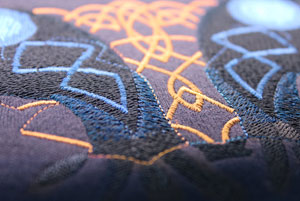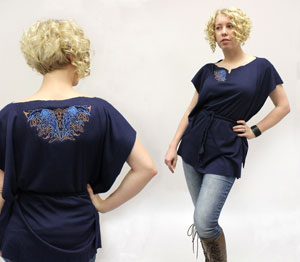Do you ever get that urge to whip something up, but just don’t feel like messing with things like seams, or even sewing? Yeah, we all feel like that sometimes. Well if you’ve always wanted to make yourself something fun to wear, but maybe haven’t had the courage to try to sew it up yourself, this is the perfect tutorial for making something quick and stylish that doesn’t require any sewing at all!
Supplies
To make your tunic, your supplies are predictably easy...
- Some no-fray fabric, so you can cut it how you like but not worry about your fabric edges fraying. I’m using a medium weight knit. You could use a T-shirt knit, but then you will have to use different, lighter designs.
- Scissors
- Cutaway stabilizer (I used a no-show mesh, which works great for garments)
- Temporary spray adhesive
- Awesome Celtic embroidery designs, designed with garments in mind!
- Grab your supplies and let's get sew-- er ... cutting.
Designs Used

Important! No matter how long you want your tunic to be, save at least three inches of extra fabric, ideally about a yard and a half long. It can be shorter, you’ll just need to tie a couple things together to get your desired length. We’ll get to that later, though...
First thing you’ll need to know is how big to make your tunic. Let’s start with the width. For my shoulders, 26 inches wide worked well for T-shirt length sleeves. Add extra inches if you prefer elbow length.
Next is the tunic length. I measured mine at about 28 inches long (note that this is with the fabric folded in half!) and it was about T-shirt length as well. You can modify this to make it any length, even into a dress! Keep in mind this "T-shirt length” measurement is based on my 5' 3" frame, so if you’re not vertically challenged like me, add a few inches.

OK, so your fabric should be folded in half and cut to your desired size. That folded edge is going to become the top of our tunic, where our head peeks through. Find the middle of that folded edge, and measure out 6 inches out either side.

You’re going to cut a small scoop into that fold like so, about 12 inches wide. Any wide than that and your tunic might start slipping off your shoulders.
The front scoop should be a little deeper than your back scoop. How deep it goes depends on how low you want your tunic to go.

Here’s how I cut mine. You can’t really tell, but the back does have a slight curve cut out of it too. It will sit in your shoulders a bit nicer.

Now we get to try on the darn thing.
Place your tunic over your head, poking your head through the hole you just cut. Now grab both the back and the front of the tunic at the same time, and pinch them together until you get a gather that you like.
This is very much based on personal preference. Ideally, you should pinch this in at your natural waist, a few inches above your hips. I gathered the fabric in a couple inches in from the edge. Mark these 4 points (the two at the front and the two at the back).

Snip a small hole at each of these points. This is where our cord is going to go through to cinch our tunic.

You might be saying to yourself... cord? What cord?
Ah ha. This is where we’re clever. Remember that three inches of fabric we saved from before? Cut that into three inch-wide strips. We’re going to braid them together to make our cord! Tie your strips together at one end and start braiding.
I started with fabric strips that were about a yard and a half long, but after being braided, they lost a little length. They were still long enough to make a good belt, but keep this in mind depending on what you’re looking for. If the fabric you bought is shorter than this, don’t worry, you can braid in extra length. If you’re feeling up to it, you can sew in some extra length... but that would break our no sew rule! Oh well. Desperate times and all that.

When you’re all done braiding, you should have this cool cord that matches your tunic.

To test it out, feed your cord first through the back two holes, and then up through the front two, where you can tie them together to see how your tunic drapes.
But wait! We’re not done yet. Far from it... we have so much more awesome to add!

OK, well, this part is totally just personal preference, but I added a little cut knotch to my tunic neckline. I think this gives your corner embroidery a nicer place to hang out.

Embroidery I say? Darn skippy. I didn’t say that this was a “no-embroidery” tunic. That would just be preposterous.
Here are some fun places I think my designs could live. Our new knotwork series have back pieces and corner pieces that are just perfect for apparel spots like these.

Hoop up your tunic with some cutaway stabilizer stuck to the back of your fabric with a bit of temporary spray adhesive, and get going! Here you can see my ravens in progress.

And all finished! So how awesome does our tunic look now?

Pretty darn awesome, if I do say so myself. Especially considering this thing was basically made with a pair of scissors and some cool Celtic embroidery.

The small raven piece (which is actually just the 4"x4" separation of the larger ravens) is a great accent on the front of my tunic.
It’s perfect to throw over just about anything, it can be made in all different lengths, and even different weight fabrics! This medium weight knit is perfect for a cool spring day, but you could use a heavy velvet for the depths of winter, or a light T-shirt knit for those hot summer days.

Better yet, it’s easy for beginners yet still comes out looking pretty darn cool. I love the slightly medieval, romantic nature of this tunic design. Plus those Celtic designs really add to the medieval flair.
Rock it this St. Paddy’s Day for some true Celtic spirit, or wear it any time you want to add a little romance to your wardrobe. When it’s this easy to make, what excuse do you have not to?


